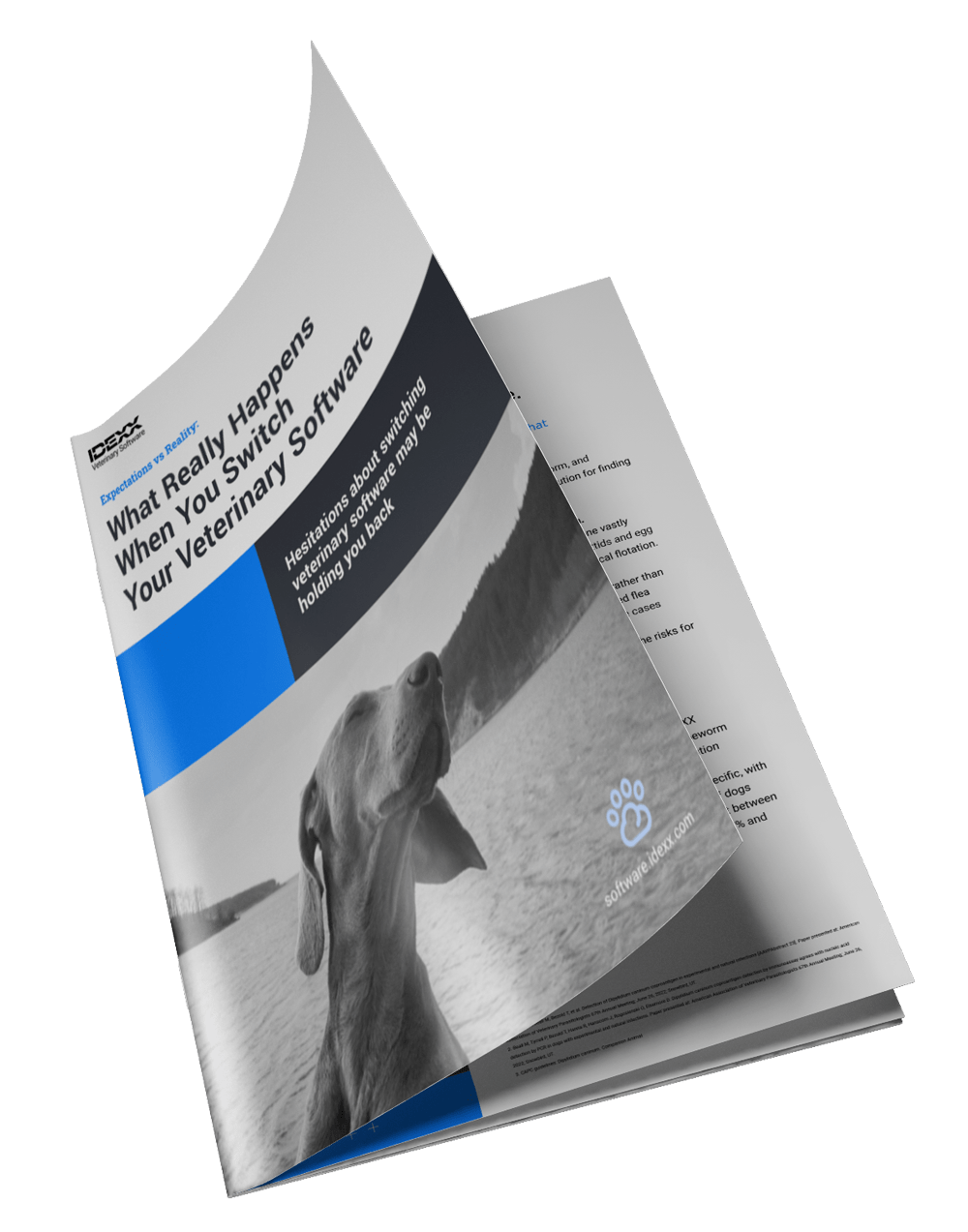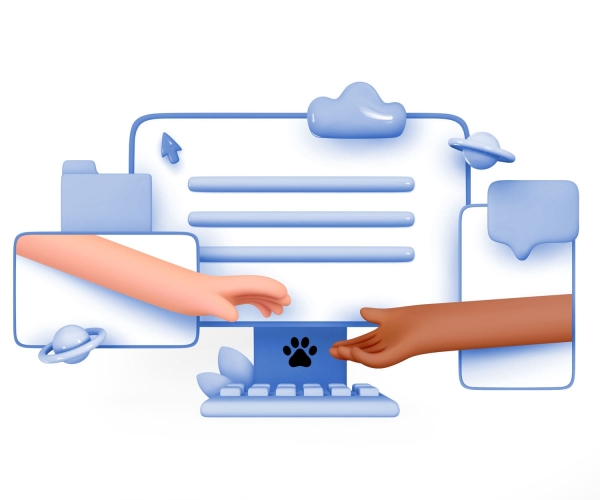Navigating Veterinary Software Change with Confidence
Learn how to manage veterinary software change successfully. Strategies, training tips & IDEXX resources to support smooth transitions.

Guiding Your Team Through Software Change
Switching veterinary software is more than a technical upgrade, it’s a people-centered transformation. Whether you’re moving from a legacy system to the cloud, consolidating multiple tools into one, or upgrading to a more modern platform, the process involves more than migrating data. It impacts your staff, your workflows, and ultimately the care you provide to patients.
Many practices underestimate the “human side” of software change. Staff can feel overwhelmed, resistant, or fearful of disruptions to daily operations. Without a structured change management approach, adoption slows, frustration builds, and the practice doesn’t realize the full return on investment.
But when change management is done well, a new veterinary software system can streamline workflows, reduce stress, and create more time for patient care and client engagement. Instead of a disruption, it becomes a practice-wide opportunity for growth.
At IDEXX, we’ve helped thousands of practices navigate software transitions successfully. We’ve seen first-hand how thoughtful preparation and guided adoption lead to better compliance, happier teams, and smoother client experiences.
If your team is drained, disengaged, or looking elsewhere, it’s worth asking: is your software making things easier, or harder?
This page walks through what contributes to low morale, how smarter systems can help, and what it looks like when tools work with your team, not against them.
On this page
- What Is Change Management in Veterinary Software?
- Common Challenges When Switching Veterinary Software
- The Payoff of Getting Change Management Right
- Practical Strategies for Successful Veterinary Software Change Management
- The Role of Modern Technology in Supporting Change
- How IDEXX Helps Veterinary Practices Transition Smoothly
- FAQs
- Building a Practice That Thrives Through Change
What Is Change Management in Veterinary Software?
Change management is the structured approach of preparing, supporting, and guiding individuals, teams, and organizations through transitions. In the veterinary world, this often means helping your staff adapt to a new practice management system (PIMS), digital payment platform, or client communication tool.

It’s not just about the technology, it’s about how people adjust to it. A software transition without change management can lead to inefficiency, low adoption rates, or even burnout. With effective planning, however, practices gain smoother rollouts, improved efficiency, and stronger team morale.
Why does it matter?
- Workforce Pressures: The veterinary profession is experiencing staffing shortages and high turnover. A 2022 Mars Veterinary Health study found that by 2030, the U.S. could face a shortage of nearly 15,000 veterinarians (Source: https://www.marsveterinary.com/reports/vet-shortage-2030). Practices cannot afford avoidable disruptions during technology changes.
- Client Expectations: Clients increasingly expect digital-first convenience: online booking, contactless payments, and real-time updates. According to the AVMA, 60% of pet owners want digital reminders and scheduling options (Source: https://avma.org/resources-tools/reports).
- Financial Impact: Software investments are significant. Without adoption, the ROI diminishes, and practices may struggle to justify costs.
Change management ensures veterinary practices align new tools with staff workflows, communicate clearly, and support adoption with training and ongoing resources. It’s the difference between implementing new software and actually transforming how your practice operates.
1. Staff Resistance
Change can feel threatening. Team members may fear losing efficiency, making mistakes, or being left behind. Long-term employees may be especially hesitant to leave behind familiar workflows.
2. Training Gaps
Even the most intuitive software requires learning. If training is rushed or inconsistent, staff adoption lags. Without proper guidance, team members may revert to old habits or workarounds.
3. Data Migration Risks
Transferring client records, invoices, and medical histories is a critical step. If migration is poorly executed, it can result in data loss, duplication, or compliance risks.
4. Operational Disruptions
Switchovers can temporarily affect scheduling, billing, or client communication. Practices fear downtime, which can impact revenue and client trust.
5. Burnout and Fatigue
Veterinary professionals are already under pressure. Adding a major software change on top of daily workloads can increase stress and fatigue if not well managed. A 2021 survey of veterinary professionals found that over 70% reported burnout symptoms, with technology frustrations being a contributing factor (Source: Merck Animal Health Veterinary Wellbeing Study – https://merck-animal-health-usa.com/veterinary-wellbeing-study).
6. Communication Gaps
When leadership fails to explain the “why” behind a software switch, staff may feel disconnected or skeptical. Without clear communication, rumors and misconceptions spread quickly.
The Payoff of Getting Change Management Right
On the other side of these challenges lies a powerful opportunity. Practices that take change management seriously see significant payoffs.
- Stronger Team Morale
When staff feel supported, trained, and listened to, morale improves. They see the software not as an obstacle but as a tool that makes their lives easier. - Higher Efficiency
Proper onboarding ensures everyone knows how to use the system effectively. Practices experience smoother workflows, faster client check-ins, and fewer manual errors. - Improved Client Experience
Clients notice when things run seamlessly. Shorter wait times, accurate invoices, and digital convenience translate into better client satisfaction and loyalty. - Measurable ROI
Change management maximizes the value of software investment. Instead of underutilized features, practices fully leverage capabilities like automated reminders, integrated payments, and reporting tools.

Practical Strategies for Successful Veterinary Software Change Management
Here are proven strategies that veterinary leaders can use to make software transitions smoother:
- Start with Clear Communication
Explain why the switch is happening, what benefits the team will gain, and how the change supports better patient care. - Involve Your Team Early
Include staff in system selection and planning. When employees feel their voices are heard, buy-in increases. Ask what features matter most to them. - Assign Change Champions
Identify a few enthusiastic team members to act as “super users.” They can test the system early, answer questions, and provide peer-to-peer support. - Prioritize Training
Don’t rush training. Schedule protected time for staff to learn. Offer multiple formats—live sessions, on-demand videos, and quick reference guides. - Manage Workload During Transition
Reduce non-essential tasks during go-live week. Consider shorter appointment blocks to give staff space to adapt without overwhelming pressure. - Plan for Data Migration Carefully
Work with your vendor to ensure accurate, secure migration of patient records and financial data. Always validate data before go-live. - Celebrate Wins
Recognize milestones—such as the first successful billing run or smooth appointment check-in. Celebrating progress reinforces morale.
Download our Guide
Expectation vs. Reality: Switching Your Software Doesn't Need to be Scary
Download Now
The right technology doesn’t just replace your old system, it supports change management by design. When evaluating software, look for solutions that:
- Offer intuitive user interfaces that reduce training time.
- Provide cloud access so your team can work securely from anywhere.
- Integrate seamlessly with diagnostic tools, payments, and communication platforms.
- Deliver analytics and reporting so you can measure progress and outcomes.
For example, IDEXX Neo is built to be user-friendly and cloud-based, making adoption faster for practices with limited IT resources. ezyVet offerszvanced workflow customization and integrations to support high-volume hospitals. Modern tools should act as a bridge, not a barrier - helping your staff embrace new ways of working without unnecessary complexity.


A simple, cloud-based PIMS designed for fast onboarding and ease of use.

A powerful, customizable system for larger practices and hospitals.

A client communication tool that reduces missed appointments and boosts compliance.

Integrated payments that streamline billing and reduce reconciliation errors.
Customer Proof Point:
A UK-based referral hospital using ezyVet reported cutting administrative time by 40% while improving client communication and reducing staff stress during its first year post-transition (Source: https://www.ezyvet.com/resources/case-studies).
- How long does it take to transition to new veterinary software?
Most transitions take between 4–8 weeks, depending on practice size, data migration needs, and training schedules. Planning ahead can significantly shorten the timeline. - Will we lose access to our old records?
No. Data migration ensures patient history, invoices, and medical notes transfer securely. Always confirm with your vendor how far back records will be migrated. - What if my staff resist the change?
Resistance is normal. Clear communication, early involvement, and structured training reduce pushback. Assigning super users as “champions” can help staff feel supported. - How do we avoid downtime during the switch?
Plan your go-live date carefully. Many practices reduce appointment load for a day or two. With proper preparation, downtime is minimal. - How much training is included?
Training varies by vendor. IDEXX provides a combination of live sessions, recorded modules, and ongoing support to ensure every team member is confident.
- Can I migrate mid-year with financial data intact?
Yes. With careful planning, financial data (including invoices and balances) can be migrated seamlessly, though some practices prefer year-end transitions for clean reporting. - How do I know if our practice is ready for new software?
If your current system feels outdated, lacks integrations, or frustrates staff, it’s time to explore options. Conduct an internal survey to gauge readiness. - Is cloud-based veterinary software secure?
Yes. Cloud systems like Neo and ezyVet use encryption, secure servers, and role-based access to protect client and patient data. - Where can I find resources to guide my team?
Start with IDEXX’s Change Management Resources for checklists, webinars, and case studies tailored to practice teams.
Building a Practice That Thrives Through Change
Switching veterinary software can feel daunting, but with the right change management strategies, it becomes an opportunity to re-energize your practice. By communicating openly, training your team, and celebrating progress, you build resilience and foster a culture that embraces growth.
Ultimately, change management isn’t just about the technology, it’s about your people. When they feel confident and supported, your new software becomes more than a tool: it becomes a catalyst for better care and stronger relationships.
At IDEXX, we’re here to guide you every step of the way. From planning to training to ongoing support, we’ve helped thousands of practices transition smoothly and unlock new levels of efficiency.
see how IDEXX can support your practice’s next chapter.

